Previous to the permanent establishment of the English in North America, the French and Spaniards made many attempts to get possession of various parts of the country. The coasts were carefully explored, and colonies planted, but they were soon given up as expensive, and involving too much hardship and danger. The first expedition to the coast of Florida was made in 1512, by Juan Ponce de Leon, renowned for his courage and warlike abilities. Ponce de Leon, becoming governor of Porto Rico (Puerto Rico), and hearing from the Indians that there existed a beautiful and fertile country to the northward, containing the waters of perpetual youth, resolved to attempt its conquest. He sailed from Porto Rico with three ships, and finally, reached the continent at about eight degrees thirty minutes, north latitude.
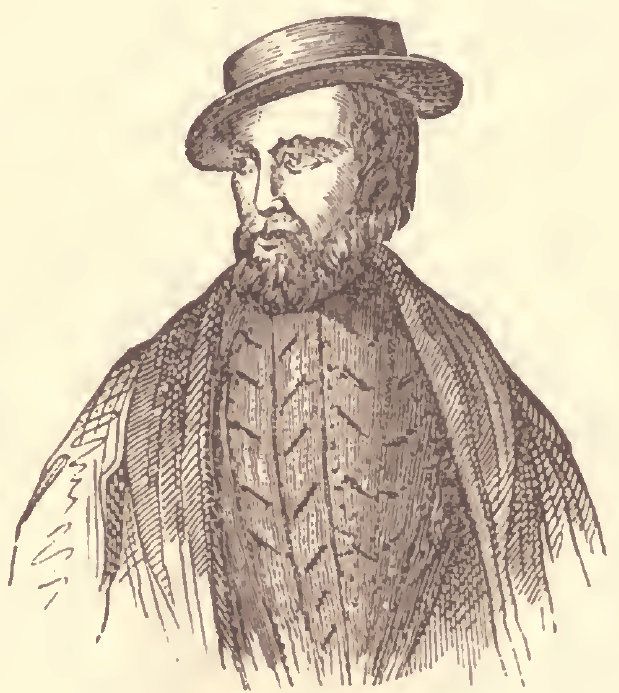
Landing on Palm Sunday, Ponce de Leon gave the country the name of Florida. He explored the coast from north to south, and had several engagements with the Indians; and though he failed to obtain the youth and treasures that he sought, he returned to Porto Rico, crowned with the luster of making a great discovery. The report of the achievements of Cortez in Mexico, again kindled the ambition of Ponce de Leon; and he set out in 1521, with two of his own ships, to make a settlement in Florida. But the Indians advanced against him; most of his men were killed, and himself so badly wounded, that he died a few days after his return to Cuba.
Another expedition, under Vasquez de Ayllon, attempted to form a settlement, in 1524. The Indians on the coast where he landed, made a feast, and induced the Spaniards to advance into the interior of the country. Two hundred men were killed there, and the others were assailed on the shore, and Vasquez de Ayllon himself fell a victim to ”the cruelty of the natives.” In 1528, Pamphilo de Narvaez, the celebrated rival of Hernando Cortez, in an expedition to the western coast of Florida, discovered the bay of Pensacola, where he landed in April, with about three hundred men. He penetrated into the interior, and marched for the high region of the Apalachees. The Indians harassed the Spaniards with an indomitable spirit; but they at last returned safely to the coast, and embarked. The vessels were afterwards wrecked, and nearly all on board perished.
Don Louis de Velasco, becoming viceroy of New Spain, fitted out another expedition for the settlement of Florida, and giving the command to Tristan de Luna, ordered him to proceed to the bay of Pensacola. De Luna reached that bay in August, 1559, and six days afterwards, lost all his fleet by a hurricane. Four hundred men were sent into the country, to procure provisions, and Luna soon followed with the rest of his forces. The Indians, awed, perhaps, by the strength of the Spaniards, were very friendly, and trafficked with them. But it could not last. The powerful Coosa tribe were at war with the Natchez, a people who refused to pay an ancient tribute; and the Spaniards were induced to join in an expedition to crush the rebels. The Natchez deserted their villages at the approach of the invaders, and crossing the river Ochehiton, believed themselves in safety. But the Coosas found a ford, and the fire arms of the Spaniards soon compelled the Natchez to submit to the terms imposed by their old lords. The trifling tribute of grain and fruit three times a year was agreed upon, and the Spaniards returned to the coast. De Luna was a man determined to overcome all obstacles in the way of his schemes. But Juan Ceron, his aid-de-camp, believed them insurmountable, and by secret machinations, contrived to prevent De Luna from pursuing his expedition any farther. It had lasted seven months, and the men were discontented.
Angel de Villafana was appointed to succeed Tristan de Luna, as commander of the Spaniards in Florida. He explored the coast, but did not attempt any permanent establishment.
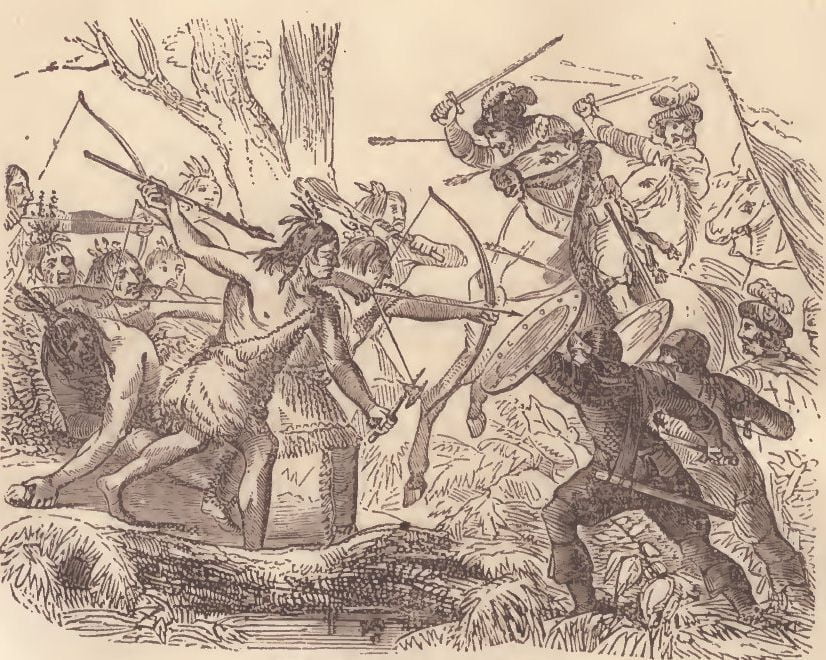
Another adventurer now appeared to try his fortune in Florida. Fernando de Soto, originally possessed of nothing but his courage and his sword, had followed the fortunes of Pizarro, and returned to Spain from Peru, laden with wealth, and crowned with the laurels of a successful warrior. His reception was brilliant; and having obtained the favor of Charles V., he sued for permission to conquer and rule the territory of Florida. Charles, ever eager to increase the extent of his dominion, created De Soto adelantado of that province. The ambitious soldier proceeded to embark his whole fortune in this grand expedition. He selected nine hundred and fifty men, most of whom were trained to arms and possessed of daring valor, and on the 6th of April, 1538, embarked his troops in ten vessels, and sailed for Cuba, which was placed under his command that he might draw from it every needful resource. There he spent a year in preparation, and received a large reinforcement of men, under command of the veteran Vasco Porcalho.
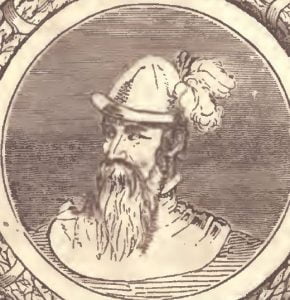
On the 18th of May, 1539, the adelantado sailed, with nine vessels, from Havanna, and on the 30th, he landed in the bay of Spiritu Santo. Twelve priests accompanied the expedition, and, a great display of religious zeal was made; yet the Spaniards brought bloodhounds with them for hunting the Indians, and chains for securing them. Hirriga, one of the native rulers whom De Soto strove to conciliate, declared his hatred of the Spaniards, and soon after attacked them; but was repulsed by Porcalho. He then abandoned his capitol, and sought refuge in the woods and marshes. Porcalho, in attempting to follow him, sunk so deep in the mud, that it was with difficulty he was rescued. His old warrior, in spite of the entreaties of De Soto then returned to Cuba.
The Spanish general now marched into the territories of Urribaracuxi and Acuera, where he met a similar reception. He strove, by every means, to mitigate the hatred of the Indians, but in vain. Although unable to meet the invaders in the field, they hovered round, and not a Spaniard could stir three hundred yards from the camp without being killed or wounded. De Soto continued to advance, and at length reached the fertile district of Acali, where the troops felt the ground firm beneath their feet. The prince of the country tendered his submission; but soon after, while the Spaniards were crossing a river, they were attacked by the Indians with a cloud of arrows. De Soto repulsed the enemy, and in keeping with his policy, refrained from revenging himself.
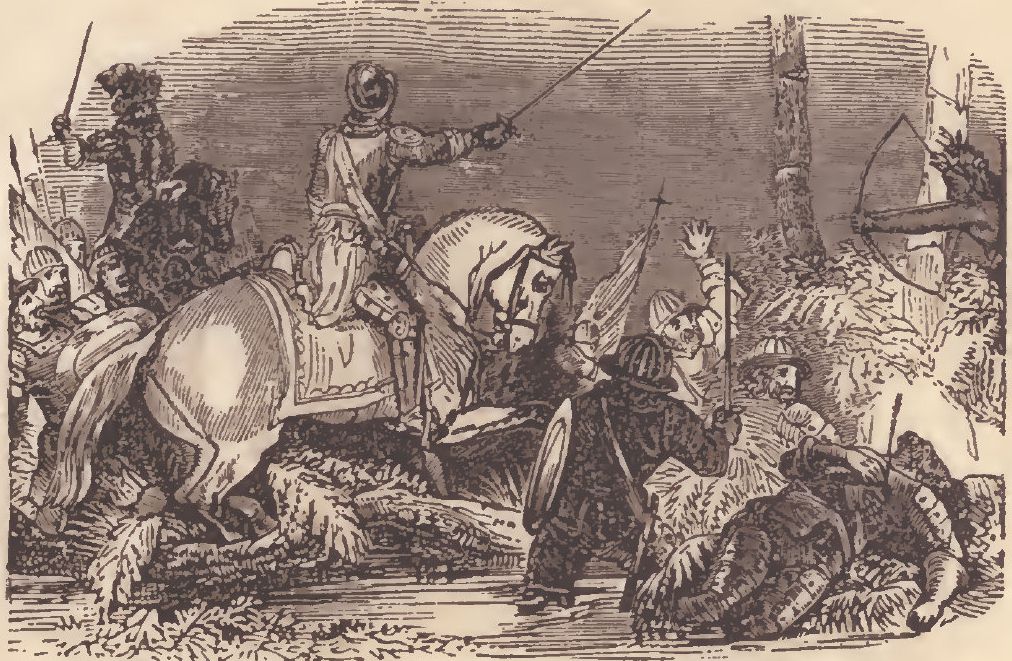
More memorable events distinguished their march through the country of Vitachuco. The chief of the natives of that country announced his determination to resist their progress; but, when the Spaniards appeared, he altered his course. De Soto was courteously received, led to the capital, and treated in the most distinguished manner. The chief summoned his warriors from every quarter as if to honor his illustrious guest. A day was appointed, when both armies were to muster in warlike array, and the Indians were secretly instructed, on a given signal, to attack the Spaniards. The latter were apprised of the plot, and were armed for the onset. As it began, the cacique was surrounded. Yet the Indians rushed on undaunted. They could not withstand the Spanish cavalry, however, and were soon dispersed. De Soto was in imminent danger during the attack, his horse being killed under him, while in the midst of the Indians. After the cavalry had rescued him and dispersed the enemy, he sought to conciliate the Indian cacique, and even invited him to his table. But his plans were not consistent. He forced the bravest of the captive warriors to perform the duties of cooks and scullions. These lofty spirits were thus inspired with the fiercest desire for revenge. A plot was formed. The servants suddenly made an attempt to kill their master, and De Soto was struck down senseless by a blow from the treacherous cacique. The Spaniards rallied, and after a short struggle, in which they lost several men, killed the greater number of the Indians, including the cacique. They then hastily left this fatal country, and marched for Appalachen.
The Indians harassed the invaders continually during the march, but could not be brought to a general action. Appalachen was deserted by its inhabitants. De Soto determined, in order to end the skirmishing, to get possession of the prince of the country, and force him to command hostilities to cease. This was accomplished. The Spaniards captured the fort of palisades in which he was confined, and seized the sovereign. After a short captivity, his subjects found means to rescue him. De Soto found no gold at Appalachen; but pleased with the country, he ordered his fleet to come from the Bay of Spiritu Santo to the neighboring coast, and resolved to spend the winter there.
During their stay, information was communicated to the Spaniards by two captives, that a country existed to the north-west, abounding in gold and precious stones; and imagining themselves to be approaching a second Peru, they eagerly marched from Appalachen, at the end of March, 1540. Four days after, they crossed a broad river, continually harassed by the attacks of the natives, who surprised and killed a small party of men. De Soto, in leaving the marshy and hostile country of Florida, adopted a more decided plan of conciliation in regard to the natives, and so far succeeded that he was allowed a free passage through their country. The guides conducted them over a long route till they came to the Savannah River. The country on the opposite bank was called Cofacique, the queen of which welcomed the invaders and supplied their wants. The country being extremely fertile, many of the Spaniards wished to settle in it, but De Soto, disappointed in not finding gold and gems, would not listen to the proposal.
In the beginning of May, the army left Cofacique, having previously excited the hostility of the natives, and captured the hospitable queen, who escaped on the frontier of her country. De Soto pursued his course through the Cherokee territory, and over branches of the Appalachians until, finding the reports concerning the country northward to be very contradictory, he determined to retreat southward and seek supplies in his rendezvous on the Gulf of Mexico. He adopted a new policy in his treatment of the natives. When he entered Coosa, he seized the person of the cacique, and compelled him to issue orders as he wished. The same system was practiced on the cacique of Tuscaloosa, a fierce and proud chief, ruling over extensive territories. He concealed his indignation at being made a prisoner, and studiously supplied the wants of the strangers; but meditated a terrible revenge. When the Spaniards reached the town of Mauvila, (Mobile) De Soto was apprised of the hostile intent of the natives, and prepared his men. At a chosen signal, thousands of enemies appeared, and a fierce conflict ensued. The Spaniards set the town on fire, and even then only succeeded in defeating their enemies after a most obstinate struggle. It is said that some thousands of the Indians fell in the battle, the invaders had eighteen killed and many severely wounded, while all their baggage was burnt in the town.
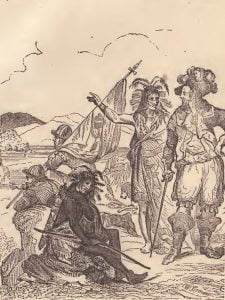
De Soto was now near the sea shore, and his men wished to return; but pride would not let him. He resolved to plunge anew into the depths of the American continent, in the hopes of finding something to reward his adventure. He directed his march northwest into the valley of the Mississippi, a region hitherto unexplored. After hard marching and fighting, he came to Chicaça, the capital of the Chickasaws. Here he passed the winter. In the spring, when the Spaniards were preparing to start, they were attacked by the natives in -the night time. They might have been all cut off had not the horses frightened the Indians, and thus aided their masters in repulsing them. Eleven Spaniards were killed, and they lost about fifty horses. Undaunted by this disaster, De Soto pushed forward till he came to the broad river Mississippi, then called Chucagna, or great river. His passage being opposed, it was twenty days before he could construct barges and transport his men. After passing through the deserted country of Aquico, he came to the country of the Kaskaskia Indians. They were conciliated, and De Soto marched as far northward as Copaha, supposed to be the territory now included in the State of Missouri. There he resolved to check his wanderings, there being no prospect of his obtaining any of the objects he sought. Proceeding westward to the White river, he turned his march southward, and descended the Red River to the Mississippi. His men were now reduced in number to fire hundred and his horses to forty. The natives were conciliated, and De Soto strove to secure reverence for his own person by persuading them he was the child of the sun. Amid his anxieties and distresses, he was seized with a fever, which in a few days closed his earthly career. On the death of their commander the troops were struck with alarm. Moscoso, his successor, attempted to conceal the event from the Indians, burying De Soto in the centre of the Father of Waters, which he had discovered. The whole party then set to work to make seven brigantines for descending the Mississippi, it having been ascertained that it was almost impossible to reach Mexico by land. When the vessels were completed, the Spaniards embarked, and after a passage of fifty-two days, during which they were pursued and harassed by the Indians, they arrived, reduced to the number of three hundred and eleven men, at the port of Panuco, Mexico. In four years they had marched upwards of five thousand miles, through a hostile wilderness; but had achieved nothing.
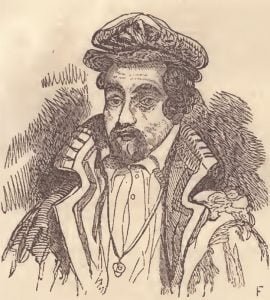
Adventurers of another nation appeared soon after to dispute the possession of the country. Acting under the orders of Admiral Coligni, who desired to found a refuge for the persecuted French colonists, Jean Ribaut, a mariner of great ability, set sail from Dieppe, February 15th, 1562, and landed on the shores of the river afterwards called St. Matthew, in the northern part of Florida, leaving Captain Albert in command at a fort built on an island in the bay of Port Royal, Ribaut then attempted to prosecute a farther voyage of discovery; but was soon obliged to return to Dieppe.
The Indians acted towards the French in a friendly manner; and when the non-arrival of reinforcements, and the want of supplies, forced them to leave the country, they furnished them with the materials for equipping a brigantine. The subsequent misfortunes of the French do not belong to this history. Another expedition, under command of Rene de Laudonniere, was sent out by Coligni, and reached the coast of Florida in June, 1524. The Indian sachems received the French in as kind a manner as before. They showed them the monument erected by Ribaut and seemed proud to make their alliance. A fort was built about two leagues from the mouth of the river St. Matthew, or May, as the French called it, and a serious attempt made to found a colony. Laudonniere often assisted the friendly tribes against their hostile neighbors; by which course he made his situation a difficult and dangerous one, although successful in the open contests with the enemy. At length, when supplies began to fail, Laudonniere broke his alliance with his former friends, and took Outina, the cacique, for whom he hoped to get a high ransom, prisoner. The Indians were irritated, and when Outina was set at liberty, they at once prepared for war. Long arrows were stuck in the fields with scalps hanging at the tops, and the navigation of the river obstructed to prevent the French from returning to Fort Carolina. Several soldiers who had strayed from the main body were cut off; and a detachment of thirty men, under Ottigny, was attacked by a large force of Indians. Several men were killed, twenty-two wounded, and the boats to which they fled had great difficulty in regaining the fort.
The French were only saved from utter ruin, by the relief extended by an English captain, named Hawkins, who, with four vessels was exploring the coast. As Laudonniere was preparing to leave the country, Jean Bibaut arrived from France, with several vessels and large reinforcements. Ribaut succeeded Laudonniere, as governor of the colony. Soon after, a large force of the Spanish Catholics, under Pedro de Melendez, arrived on the coast and established the fort St. Augustine. The object of the Spaniards was the expulsion of the Protestant French from Florida. In the bloody scenes which followed, throwing a detest-able infamy on the name of the savage Melendez, the Indians took no part. It is enough to say, that the French were all either butchered, or driven out of the country.
When, in the latter part of 1567, Dominic de Gorgues came to Florida to revenge the massacre of his countrymen, the Indians joined him, in great force. The Spanish forts, which were under command of Villareal, were attacked in a furious manner, and the enemy being placed between two fires, but few escaped. Many were taken and reserved for a more dreadful death. They were hung on trees, and the inscription, “I do not this as unto Spaniards and mariners, but as unto traitors, robbers and murderers,” was placed over them by the revengeful De Gorgues. After receiving the congratulations of the Indians, as their deliverer, he then returned to France. No further attempts were made to establish colonies in Florida by the French, although it had been proved that the Indians, when well treated, were kindly disposed, and willing to assist them.
